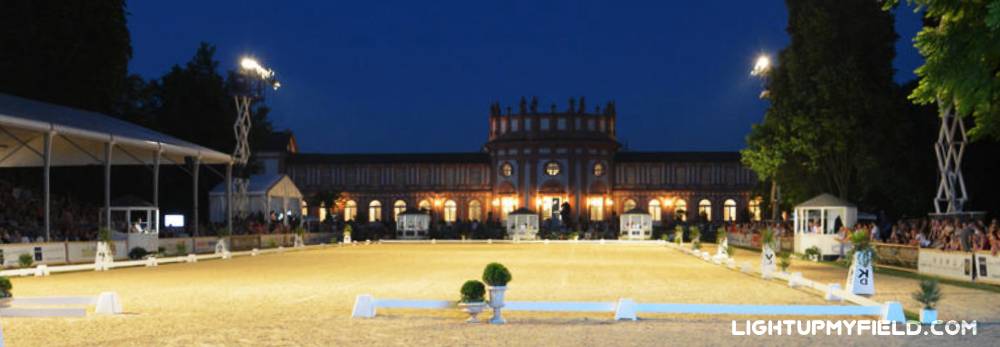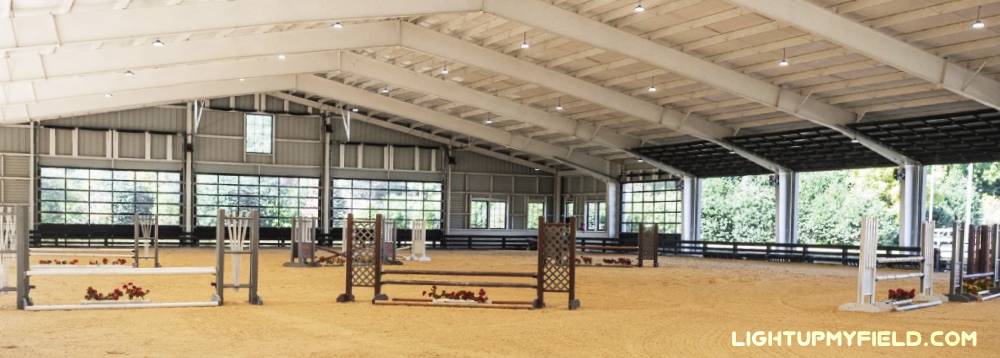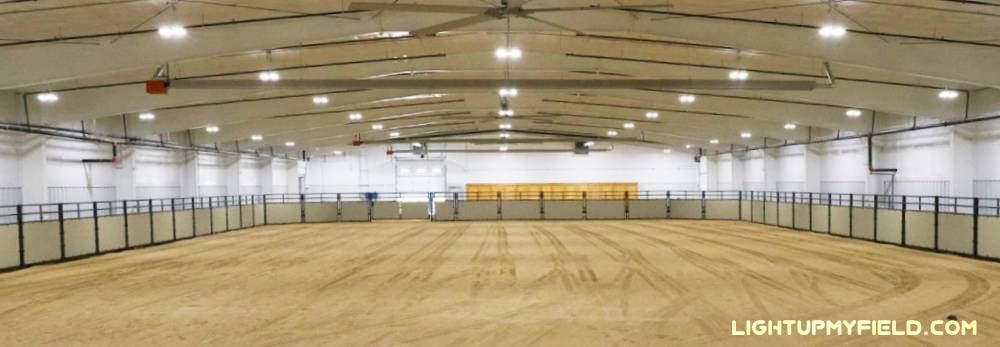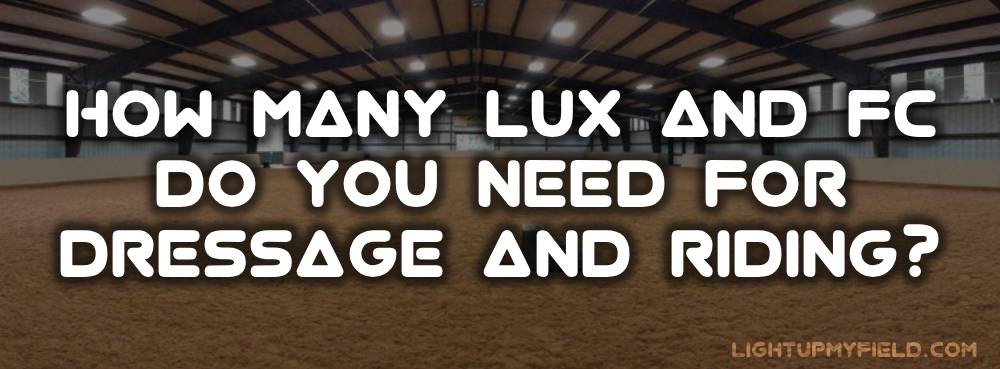Lighting can really make or break the riding experience, whether you’re training for a competition, teaching lessons, or just enjoying some quiet time in the saddle. For horse and rider, good visibility means smoother communication, better performance, and safer footing. But how bright should an arena actually be? Too dim and you’re squinting; too bright and your horse might shy away. Getting the numbers right — in both lux and foot-candles (fc) — is key for comfort and performance in disciplines like dressage, show jumping, and general riding.
Table of Contents
ToggleUnderstanding Lux and Foot-Candles
Lux and foot-candles are just two ways to measure the same thing: light falling on a surface. Lux is the metric unit, while foot-candles are the imperial version. One foot-candle equals about 10.76 lux, so you can easily convert between them depending on which system you’re using.
If you imagine holding a light meter over the surface of your arena, lux and fc tell you how much light is actually hitting that spot. More lux/fc means more brightness, but that doesn’t automatically mean “better” — the trick is matching the light level to your discipline and the way you and your horses work.
Typical Lux & Fc Levels for Riding Arenas
Dressage – Lighting for Precision and Detail

Dressage is all about subtle communication — the tiniest shift in a rider’s seat, a fractional change in rein pressure, or a barely visible flexion in the horse’s poll. If the lighting isn’t right, those small cues are much harder to see and feel. For most training sessions, aiming for around 500 lux (about 46 foot-candles) works beautifully, giving enough clarity without feeling glaring.
When it comes to competitions, especially those judged in person and filmed for broadcast, the stakes get higher. The standard often jumps to 800 lux (roughly 74 foot-candles) or even a touch more. At this level, judges can clearly spot details like the precision of a half-pass or the symmetry of a pirouette, and camera crews can capture footage that looks crisp instead of flat. Imagine riding a freestyle under dim lights — the beauty of the test just doesn’t come through the same way.
It’s worth remembering that a 20 × 60 meter dressage arena lit to 800 lux evenly across the surface will need carefully spaced lights to avoid shadow bands, particularly near the short sides where horses and riders often perform movements close to the wall.
Show Jumping – Brightness for Fast Reactions

Show jumping brings an entirely different lighting challenge. Here, it’s not just about detail — it’s about speed and depth perception. A horse galloping toward a 1.40 m oxer needs to clearly see the jump, judge its height, and read the ground line all in a split second. Riders, too, rely on quick visual feedback to adjust strides before takeoff.
For everyday training, a baseline of at least 700 lux (around 65 foot-candles) is recommended to keep distances clear and reduce the chance of hesitation. But for competitions — particularly in evening shows or indoor arenas — that level rises to 900–1,000 lux (about 84–93 fc). This extra brightness makes a real difference in high-pressure rounds, where a fraction of a second can mean the difference between clearing the jump and knocking a rail.
There’s also the matter of shadows. At lower light levels, jumps can appear darker against the arena footing, which may cause horses to back off. With stronger, more evenly spread lighting, fences remain clearly visible from takeoff to landing, which helps maintain rhythm and confidence.
General Riding and Schooling – Comfortable, Not Overpowering
Not every ride needs competition-level brightness. For casual hacks, riding lessons, or light schooling sessions, something in the range of 200–300 lux (about 19–28 foot-candles) usually does the trick. This gives you and your horse enough light to see each other’s movements, read the footing, and avoid accidents, without turning the arena into a floodlit stadium.
If most of your rides happen during the day and you only need lights for the early morning or after sunset, this range is a good balance between comfort and energy efficiency. For example, a small 20 × 40 meter arena might reach 250 lux with just 8–10 modern LED fixtures at 150 watts each, keeping running costs low while still delivering clear, even coverage.
That said, even for general riding, uniformity matters just as much as total brightness. A well-lit center with dark, shadowy corners can spook a horse or make a lesson feel uneven. Keeping the light level within about 20–30% of the average across the whole arena helps avoid those “bright here, dim there” problems that can throw off both horse and rider.
| Discipline / Use | Training Lux (fc) | Competition Lux (fc) |
|---|---|---|
| Dressage | 500 lux (≈46 fc) | 800 lux (≈74 fc) |
| Show Jumping | 700 lux (≈65 fc) | 900–1,000 lux (≈84–93 fc) |
| General Riding / Schooling | 200–300 lux (≈19–28 fc) | — |
When Lighting is Too Bright or Too Dim
How Horses React to Lighting Changes
Horses see the world differently than we do. Their eyes are built for detecting movement and seeing well in low light, but they don’t handle sudden lighting changes quickly. Moving from a dim corner to an area lit with overly strong lights can leave them momentarily “blinded” as their pupils adjust. If your arena lighting pushes past 1,200 lux without careful placement, it can cause a glare that feels uncomfortable for both horse and rider.
Too much brightness can also create sharp, high-contrast shadows. To a horse, a deep shadow on the footing might look like a hole or an object to avoid. You might notice them hesitate, sidestep, or even refuse a jump because of a dark patch that you barely notice. This is especially true for younger or less experienced horses that haven’t learned to trust the arena environment yet.
On the flip side, lighting that’s too dim — say under 150 lux for fast-paced riding — can cause more subtle but equally troublesome problems. Horses rely on visual cues to read footing conditions, judge fence distances, and spot other horses in their path. In darker environments, they may misjudge where to put their feet, leading to stumbling, tripping, or awkward takeoffs. At a trot, this might just feel clumsy; at a canter or gallop, it can be dangerous.
The Rider’s Side of the Story
For riders, overly bright lights can feel just as uncomfortable. High glare can make it difficult to focus on your horse’s outline or the approach to a jump, and after a while, your eyes feel strained. This fatigue can creep in over a training session and subtly affect timing and decision-making.
Dim lighting brings its own issues. In low light, the human eye struggles with depth perception and contrast, meaning obstacles and footing changes don’t “pop” visually. Even a delay of half a second in processing what’s ahead can make a big difference — especially in disciplines like show jumping or eventing, where precision and timing are everything. For example, missing the ideal takeoff spot by just 30–40 cm because you couldn’t judge the distance clearly can easily mean hitting a rail.
Lighting that is neither too harsh nor too dull, and that’s evenly spread across the arena, allows both horse and rider to perform with confidence. It’s not just about visibility — it’s about keeping the rhythm, trust, and connection between you and your horse.

How to Plan the Right Lux Level for Your Arena Lighting
Getting your arena lighting right isn’t just a case of picking a lux number and grabbing the first set of lights you see online. The brightness target is only the starting point. The real magic happens when you match lux level, beam angle, mounting height, uniformity, and arena size so they all work together.
Matching Lux Targets to Your Space
Let’s take a standard 20 × 60 meter dressage arena as an example. If your goal is 500–600 lux for regular training, you might be looking at roughly 18–20 LED fixtures in the 150–200 watt range. That’s assuming the lights are mounted around 6–8 meters high and spaced to cover the arena evenly. But if you go with wider beam angles and mount them strategically to avoid hot spots and dark zones, you could get the same effect with fewer fixtures, which means lower upfront costs.
Why Beam Angle and Mounting Height Matter
The beam angle — basically, how wide the light spreads — affects how many lamps you need and how evenly the arena gets lit. A narrow beam will throw light farther but can create bright patches, while a wide beam covers more ground but loses intensity faster. Mounting height also plays a role: lower mounts can make the arena feel brighter but can cast longer shadows; higher mounts spread light more evenly but need a bit more power to maintain the same lux level on the ground.
For example, in a show jumping arena that’s 30 × 70 meters, mounting at 8–10 meters with a medium beam angle can keep shadows under fences to a minimum and maintain 700–900 lux across the board.
Keeping the Light Even Everywhere
Uniformity is just as valuable as overall brightness. A perfectly lit centerline doesn’t help much if the corners are so dark that horses spook going into them. A good benchmark is a uniformity ratio of 0.6–0.7, meaning the darkest spot in the arena should still be at least 60–70% as bright as the brightest spot. That way, the horse’s eyes don’t have to constantly readjust as you ride from one end to the other.
You can test this with a basic light meter (or even a smartphone app, though pro meters are more accurate) by taking readings in multiple spots and comparing the results.
Balancing Performance with Energy Use
Bright, even lighting doesn’t have to mean sky-high electricity bills. Switching to high-quality LED sports fixtures can cut power consumption by 50–70% compared to older metal halide or halogen setups. LEDs also maintain their brightness much better over time, meaning you won’t find yourself riding under “fading” lights after just a year or two.
It’s worth factoring in maintenance too. LEDs can run 50,000+ hours before significant output loss, which for most arenas means several years of consistent use before replacement. That’s less time up on ladders changing bulbs and more time in the saddle.
Finding the Sweet Spot for Your Arena
Whether you’re chasing clean dressage lines, fast jump rounds, or just a comfortable evening hack, having the right light level makes a difference you’ll notice every ride. The ideal brightness depends on what you’re doing, how big your space is, and even how your horses react to different lighting conditions. Balancing comfort, visibility, and consistency will give both horse and rider the best shot at confident, enjoyable sessions — and you might find that once you get it right, you never want to go back to “good enough” lighting.

